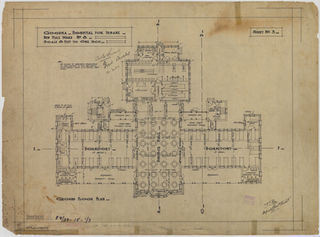

There Was Once an Asylum



This site not only provides an overview of mental health history and its implications for Goodna, but also explores the complex relationship between memory and history
There are stories we may never know, but this site uncovers the history, revealing the layers of understanding that form the foundation of the present.
It is done in a way that honours the patients, clients, and the people.
Lewis, McDonnell, Noble Houses
Built-in 1915
Lewis House, McDonnell House, and Noble House (former male patient wards 9, 10, 11, 12, 13) are three similar buildings standing in a line northeast of Kelsey House. Purpose-built as male ward buildings, they express their original use through architectural details and features designed for incarcerated patient management and reflect the principles of moral treatment. Surrounded by open lawns, they face southeast toward the Recreation Grounds, and their primary access is on this side of the buildings.
In 2020, they are vacant and had most later fabric removed, as well as most internal fittings and finishes.
The timber ground floor structure has been replaced by a concrete slab, and the original rear bathroom wings have been demolished. Chimneys have been demolished down to roof level, and verandahs and bay windows on Lewis House and Noble House have been demolished. McDonnell House has had its projecting rear stairwells demolished.
Features of Lewis House, McDonnell House, and Noble House of state-level cultural heritage significance also include:
• Massing, form, construction: two-storey, lowset, freestanding brick structures with timber and steel-framed floors, and timber-framed verandahs and roofs (gable and hip) with ventilated Dutch gables
• Symmetrical plan forms: Lewis House and Noble House are identical H-shaped buildings with similar ground and first-floor plans.
The middle wing has a row of single patient rooms and a large day room with a verandah on its southeastern side.
The northern wing has a communal patients’ dining room, scullery, and attendants’ bedrooms.
The southern wing has two dormitories and two small projecting rooms for toilets and a stairwell. McDonnell House is cruciform in plan, comprising a large central dining room with wide openings into large dormitories on either side, with verandahs along their southeast side. Two small projecting rooms (toilets, single patient room, and attendant’s room) are at both ends
• Architectural detailing for incarcerated patient management (security, safety, hygiene, moral treatment): o orientation and views out from verandahs, dining rooms, and dormitories to the Recreation Ground and its cricket oval efficient and logical room layouts; wards of dormitories and single rooms; communal ablutions for males only; centralised supplies stores o robust and cleanable/hygienic materials and finishes: face brick external walls (ground floor); roughcast rendered walls (central and end bays and first floor) with face brick quoins; concrete sills and lintels; plaster interior walls; timber board floors (first floor); ceramic bathroom tiles (floors and walls); terracotta tile roof cladding; cast iron and metal water goods; bracketed concrete hoods over entrance doors measures for safety, security, and observation of patients: rounded and coved external and internal wall and floor corners; observation doors and windows; small high-level windows above single patient room doors (some have been blocked up); toilet cubicles without doors high levels of natural light and ventilation to the interior: spacious rooms with high ceilings; large windows; battened eaves; timber ventilation louvres in gable ends.
























